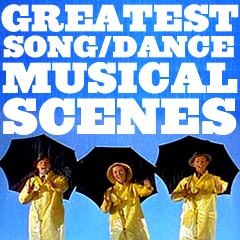
|
Musical Moments and Scenes L - 2 |
| L (continued) | ||
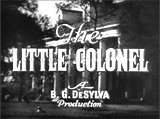
|
The Little Colonel (1935)
In Shirley Temple's first costume picture, she performed her first tap-dance pairing with Bill "Bojangles" Robinson. It was the celebrated stairway dance scene in which young Lloyd Sherman (Shirley Temple) tapped side-by-side down and then up a staircase with Walker (Bill Robinson), her grandfather Colonel Lloyd’s butler. [Note: Their tap dancing duet was reprised with their competitive "challenge dance" up and down wooden apartment steps in The Littlest Rebel (1935) (see below).] |
    
|
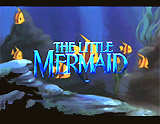
|
The Little Mermaid (1989)
This popular Disney animation, a musical fantasy, was the studio's first animated fairy tale since Sleeping Beauty (1959). It told about the wishes of a 16 year-old "little mermaid" (a princess named Ariel) to become a human. It featured Caribbean (Jamaican Rastafarian), red-colored Sebastian the Crab's (voice of Samuel E. Wright) Oscar-nominated and winning, show-stopping calypso number Under the Sea (pictured) (with music by Alan Menken and lyrics by Howard Ashman, both Broadway songwriters). Its lyrics were memorable, as Sebastian tried to convince Ariel to remain aquatic and carefree under the water: ("Under the sea Under the sea Nobody beat us Fry us and eat us In fricassee We what the land folks loves to cook Under the sea we off the hook We got no troubles Life is the bubbles Under the sea...") Other memorable tunes included:
|
   
|
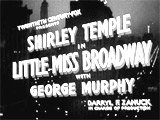
|
Little Miss Broadway (1938) In this storybook musical comedy from 20th Century Fox, a slightly older Shirley Temple (as Betsy Brown) sang Be Optimistic (pictured) with the Brewster twins -- the song was a tonic for Depression-era audiences. |

|
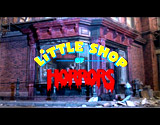
|
Little Shop of Horrors (1986) This satirical musical film, based upon Roger Corman's 1960 classic B-film black comedy of the same name and the off-Broadway stage hit musical in the early 80s, told about a timid florist shop clerk named Seymour Krelborn (Rick Moranis) who discovered a carnivorous (and singing) venus flytrap plant from outerspace named Audrey II. The film featured a trio of doo-wop singers (a girl group "Greek Chorus" comprised of Michelle Weeks, Tichina Arnold and Tisha Campbell) who sang the title song Little Shop of Horrors (pictured) during the opening credits. Later, they also sang The Meek Shall Inherit. One of the funniest numbers was Steve Martin's (as sadistic dentist Orin Scrivello) Elvis-like performance of Dentist! (pictured). Buxom bimbo and shrill-voiced flower arranger Audrey (Ellen Greene) - the object of Seymour's infatuated crush - and Seymour sang a duet together: Suddenly Seymour (pictured twice):
Also included was the the show-stopping rock-bop tune Downtown (Skid Row) (pictured) sung by the cast - the entire neighborhood of bums, drunks, prostitutes, and lower class apartment dwellers, and Seymour's heart-felt plea to his new-found plant Grow for Me (pictured). There were three great songs by the giant, carnivorous fly-trap plant Audrey II (voice of The Four Tops' Levi Stubbs) menacing Seymour:
[Note: Preview audiences did not like the nihilistic,
downbeat conclusion of the original version of the film (a 23-minute
alternate ending) - so the ending was re-shot to include the death
of Audrey II and an upbeat 'Sandra Dee' conclusion, rather than keeping
Audrey II's eating of Seymour and takeover of Earth. |
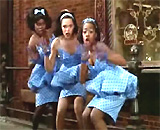 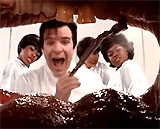   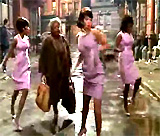 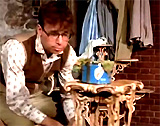 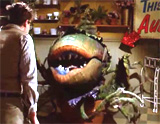 
|

|
The
Littlest Rebel (1935) In The Littlest Rebel (1935):
|
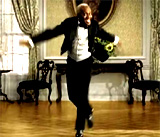   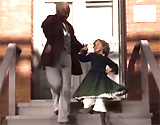
|

|
Love Actually (2003, UK/US) One of the more memorable dance scenes was recently-elected Prime Minister's (Hugh Grant) impromptu dance to the golden-oldie Jump by the Pointer Sisters (pictured often), when he cavorted from his bedroom and down the stairs in his big mansion on 10 Downing Street - and was observed from afar by one of his astonished staffers. |
  
|

|
Love Is A Many-Splendored Thing (1955)
Han Suyin's 1952 autobiographical novel was turned into this Henry King-directed Cinemascopic romantic drama about a transgressive, inter-racial/cross-cultural relationship, filmed on location in Hong Kong. Of its eight Academy Award nominations, this film won three Oscars: Best Score (Alfred Newman), Best Song (music by Sammy Fain, lyrics by Paul Francis Webster), and Best Costume Design. Its other nominations were for Best Picture, Best Actress (Jennifer Jones), Best Art Direction, Best Cinematography, and Best Sound. Often during the film, the title song would swell in the background. It told about two lovers in a clandestine relationship during China's Civil War in 1949:
In a melodramatic final scene set in Hong Kong, Mark reluctantly bid her farewell from a hilltop (where they often went to share kisses) - he told her that he didn't have a present for her: "I have to go now and I don't want you to be sad...And I don't want you to come down the path with me. I want to look back and see you here." She promised that she would be there for him at their familiar meeting place ("I will be here when you come back to me. I promise") as they kissed and the theme music swelled - with the lyrics:
|
 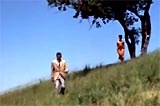
|

|
Love Me Tonight (1932)
This innovative musical masterpiece from Paramount and director Rouben Mamoulian, with a Rodgers and Hart score, set the pattern for future seamlessly integrated musicals. It starred Maurice Chevalier (as Parisian tailor mistaken for a baron Maurice Courtelin) and Jeanette MacDonald (as melancholy and frustrated noblewoman Princess Jeanette). The film opened during the credits with a 'symphony of noises' sequence, capturing the rhythms and sounds of Paris awakening -- (i.e., bell-ringing, pick-axing a cobblestone street, a man's snoring, broom-sweeping, smokestack-churning, a baby's crying, filing, rug-shaking and beating, boot-making, car-horns honking, etc.) while Chevalier was introduced in his small apartment bedroom, singing That's the Song of Paree (pictured). The Parisian tailor was also linked to the Princess in their classic rendition of Isn't it Romantic? (pictured twice) - the catchy tune was passed through time and space (from Chevalier's 'Tailleur' shop where he was tending to a customer, to people in the street, and into the countryside on a train, and then into MacDonald's country chateau where she was singing on her open balcony). The two were linked together by different characters (a shop customer, a taxi driver and his composer customer, soldiers on the train that emerged marching, and a gypsy violinist). Of the nine staged musical numbers, other songs included:
|
     
|

|
The Love Parade (1929) This Paramount film with six Oscar nominations often combined director Ernst Lubitsch's sophisticated touch and sexual innuendo - while many of the songs were cleverly integrated into the storyline. It had a number of milestones. It was:
The couple were married although unhappily due to his powerless role as spouse, although he was persuaded not to divorce and the couple eventually learned to compromise. A wide variety of delightful and lilting numbers included:
|
    
|
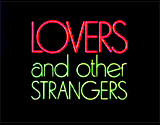
|
Lovers and Other Strangers (1970)
Director Cy Howard's hit family comedy from ABC Pictures was the recipient of three Academy Award nominations, including Best Supporting Actor (Richard S. Castellano) and Best Adapted Screenplay. It was based upon the 1968 Broadway hit play by Renée Taylor and her husband Joseph Bologna. The ensemble "sleeper" hit film won a sole award: Best Original Song for the romantic ode For All We Know (music by Fred Karlin and lyrics by Robb Royer and Jimmy Griffin), beautifully sung by Karen Carpenter (of the Carpenters) in the film.
The song was heard on the soundtrack during the wedding sequence (the central plot point) between two of the major characters:
The comedy also marked the film debut of Diane Keaton in a minor role as Joan Vecchio, the unhappy wife of the brother of the groom. |

|

|
Lucky Me (1954) This musical (the first shot in widescreen Cinemascope) about romantic misunderstandings starred Doris Day (as traveling show singer/actress Candy Williams) along with Phil Silvers (as Hap Schneider), Nancy Walker (as Flo Neely), and Eddie Foy Jr. (as Duke McGee) -- stranded troupers and theatrical entertainers who were forced to work in an expensive Miami hotel after they ordered a large meal and were unable to pay the bill. Robert Cummings also starred as philandering NY songwriter Dick Carson staying at the hotel. In the film's opening, there were shots of the streets of Miami, followed by Candy Williams (Doris Day) strolling along the street (actually an obvious Hollywood soundstage) - with inventive tracking shots - singing Superstition (pictured). She also performed High Hopes (pictured) - a lively song and dance number with the ensemble:
Other popular tunes included:
|
     
|

|
Lullaby of Broadway (1951) In this Technicolored Warners' musical romance drama by director Lloyd Bacon, noted for gorgeous costumes, charming blonde-haired Doris Day starred as young, unknown American singer/actress Melinda Howard. She arrived in New York from London, and was soon to discover that her mother Jessica Howard (Gladys George) was not really a big and successful Broadway star, but a has-been alcoholic. Gene Nelson co-starred as Doris Day's fellow-entertainer and love interest Tom Farnham. The musical was a remake of Honky Tonk (1929) - that starred Sophie Tucker (the Gladys George role) and Lila Lee (the Doris Day role). Many of the hit songs in the film were vintage Warners' tunes written by Al Dubin and Harry Warren, and others were by George Gershwin and Cole Porter. In the opening, a tuxedoed Day with a top hat and cane -- looking like Eleanor Powell -- sang and danced Cole Porter's Just One of Those Things (pictured). Other numbers included:
|
     
|
(alphabetical by film title) Introduction | A-1 | A-2 | B-1 | B-2 | B-3 | C-1 | C-2 | D-1 | D-2 | E | F-1 | F-2 | G-1 | G-2 H-1 | H-2 | I-J | K | L-1 | L-2 | M-1 | M-2 | N-O | P-1 | P-2 | R-1 | R-2 | S-1 | S-2 | S-3 | T | U-V | W | X-Z |